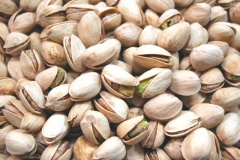Pistachio nuts
| Infobox on Pistachio nuts | |
|---|---|
| Example of Pistachio nuts |  |
| Facts | |
| Origin | - |
| Stowage factor (in m3/t) | - |
| Humidity / moisture |
|
| Oil content | - |
| Ventilation | See text |
| Risk factors | See text |
Pistachio nuts
Shipment / Storage / Risk factors
Pistachio nuts are often shipped in cartons. Used in confectionery; oil is also extracted which is used as a flavouring. Contact with water or moisture may cause a change in taste and quality. Liable to infestation or exposure to heat; exposure to sun will cause dryness and a change in taste. When stored for long periods of time without adequate ventilation the nuts will deteriorate, giving off a strong odour.
Bulk container shipments of pistachio kernels are prone to self-heating and spontaneous combustion because of their high fat (45 - 55%) and low water content.
Acceptable pistachio nuts must be of sound average quality, dry, predominantly greenish (old nuts are often of a yellowish color), contain no dust or foreign admixtures and have their characteristic odour and flavour. 95 - 98% of nuts in their shell must be open. Pistachio nuts from the previous year's harvest have a tendency to beetle infestation and rancidity.
Recommended ventilation conditions for pistachio nuts are an air exchange rate of at least 10 changes/hour (airing).
Airtight packaging is ideal because pistachio kernels readily absorb moisture from the air, so becoming limp and because oxygen promotes rancidity.
Roasted and salted nuts may be stored under cool, well ventilated and dry conditions for up to three weeks and for a little longer in winter. If the maximum duration of storage is exceeded, quality may be impaired, e.g. loss of the brilliant green color and rancidity.
See also Nuts and Kernels











